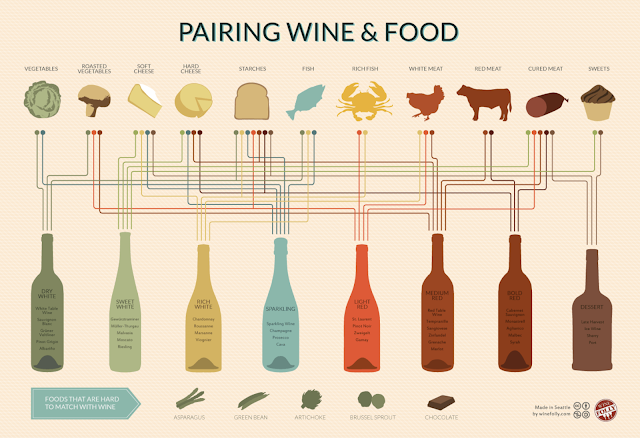Imagine ... you’re sat at a lovely restaurant with friends, the menu looks incredible, and everyone’s excited. Then the waiter hands over the wine list — pages and pages of unfamiliar names, grape varieties, regions you’ve never heard of — and suddenly the pressure’s on. You’re tasked with choosing the wine that’ll magically complement everyone’s meal. Gulp.
Sound familiar? You’re not alone. Food and wine pairing can feel like a mysterious art reserved for sommeliers and wine buffs. But here’s the thing: with a few simple tips, you can master the basics and enjoy your food and wine pairing experience without the stress.
Let’s take a tour through the wonderful world of matching wine with food — and I’ll share some real-world advice to help you navigate those tricky situations with confidence.
Classic Food and Wine Pairing Ideas
1. Red Meat & Bold Reds
The most well-known rule — red wine with red meat. Why does it work? Red wines like Cabernet Sauvignon, Malbec, or Syrah have tannins (those slightly drying, grippy elements) that complement the rich fats in steak, lamb, or venison. The tannins cut through the meat's fattiness, while the meat softens the tannins, making the wine feel smoother.
Next time you're having a juicy ribeye, reach for a Cabernet Sauvignon or a spicy Shiraz. Trust me, they’ll elevate each other beautifully.
2. White Meat & Versatile Whites
Chicken, turkey, or pork can pair with both reds and whites, but for simplicity, stick with a crisp white like Sauvignon Blanc or Chardonnay. A lightly oaked Chardonnay complements roast chicken, while Sauvignon Blanc's zesty acidity works wonders with grilled chicken salads or herb-based dishes.
The freshness of the wine brings out the natural flavours without overpowering them — a perfect balance for those more delicate meats.
3. Seafood & Crisp Whites (or a Light Red)
Fish and shellfish typically call for white wine, thanks to their subtle flavours and lighter texture. Think Pinot Grigio with prawns, Sauvignon Blanc with oysters, or a buttery Chardonnay with salmon.
Feeling rebellious? You can pair certain seafood dishes with red wine — a chilled Pinot Noir with seared tuna is an absolute treat.
4. Cheese & Wine — The Iconic Duo
You might’ve heard the saying “what grows together, goes together.” French Brie with a glass of Champagne? Classic. A nutty Manchego with Spanish Tempranillo? Divine.
But not all cheeses love red wine — soft, creamy cheeses often work better with whites or sparkling wines, as the acidity cuts through the richness. Meanwhile, aged hard cheeses (like Cheddar or Parmesan) stand up to fuller reds.
Common Wine Pairing Dilemmas (And How to Handle Them)
Dilemma 1: "We're all ordering different dishes — how do I choose one wine?"
This happens all the time, especially at group dinners. The trick? Find a versatile crowd-pleaser. For whites, a dry Riesling or unoaked Chardonnay. For reds, a Pinot Noir or Grenache. These wines are food-friendly, with balanced acidity and moderate body, meaning they’ll complement a range of dishes without clashing.
Dilemma 2: "I love spicy food, but wine always tastes odd with it."
Spicy dishes — Thai curries, Indian food, Mexican tacos — can overwhelm wine or make it taste harsh. Go for slightly off-dry whites like Riesling or Gewürztraminer. Their touch of sweetness cools the heat and enhances the spices. Avoid high-alcohol reds — they’ll only intensify the fire.
Dilemma 3: "Is rosé only for summer picnics?"
Absolutely not! Rosé is a brilliant, often underrated, choice for food and wine pairing year-round. Dry rosé, especially from Provence, complements everything from grilled seafood to Mediterranean salads to light pasta dishes. It bridges the gap between red and white, making it flexible for meals with mixed plates.
Dilemma 4: "I like sweet wine, but it feels childish — is it acceptable?"
First of all, there’s no shame in enjoying sweet wine — and there are elegant, complex options beyond supermarket Lambrini. Sweet wines like Sauternes or Tokaji pair superbly with strong cheeses (like blue cheese), foie gras, or desserts. A well-matched sweet wine brings balance, not just sugar, creating an indulgent harmony.
Quickfire Food and Wine Pairing Tips
Acidic foods (like tomato-based pasta) need acidic wines — try Chianti or Sauvignon Blanc.
Fatty dishes (creamy pasta, buttery sauces) love wines with freshness or bubbles — think Champagne or crisp whites.
Bitter foods (like rocket, olives, dark greens) can clash with tannic reds — opt for lower-tannin wines like Pinot Noir.
Sweet dishes? Make sure your wine is sweeter than the food — otherwise, the wine will taste flat or sour.
Food and wine pairing doesn’t have to be intimidating — it’s about enhancing flavours, balancing contrasts, and most importantly, enjoying the experience.
Final Thoughts: Relax and Experiment
There’s a lot of tradition, advice, and science behind food and wine pairing — but at the end of the day, your preferences matter most. If you love red wine with fish, or bubbles with steak, go for it! The rules are guides, not laws.
Next time you’re handed the wine list or stocking up for a dinner party, think about the balance of flavours: acidity, sweetness, fat, spice, texture. You’ll find your confidence grows, and your meals become even more enjoyable.
And remember, experimenting is part of the fun — every meal is a chance to discover a new favourite combination.
Cheers to good food, great company, and perfectly paired wine.
If you know someone who might find this helpful, don’t keep it to yourself—please share it.
You never know how much of a difference it could make in someone’s life.
Liked what you read? I'd appreciate if you bought me a coffee - it encourages me to keep writing helpful articles like this one. Just click the link below to send a small tip my way. It's quick and secure! Thank you very much!




Comments
Post a Comment